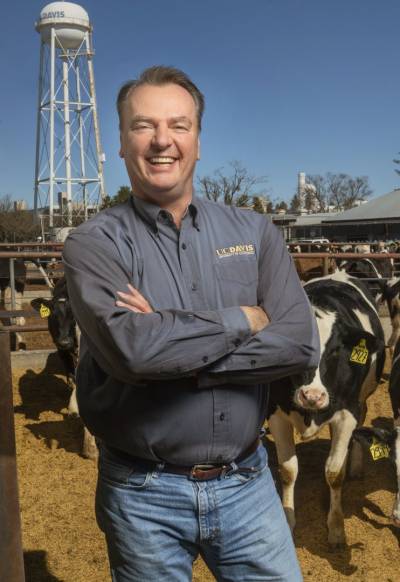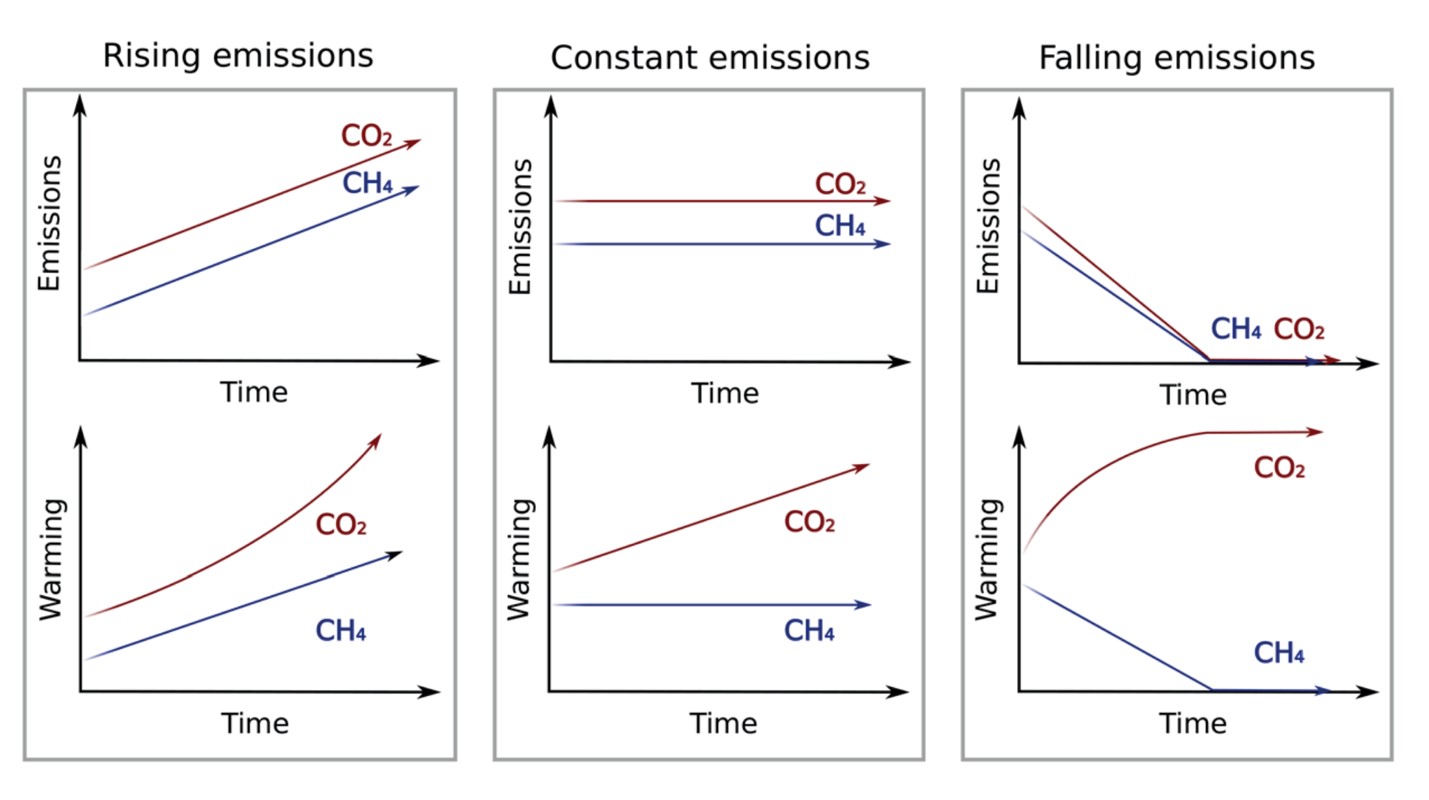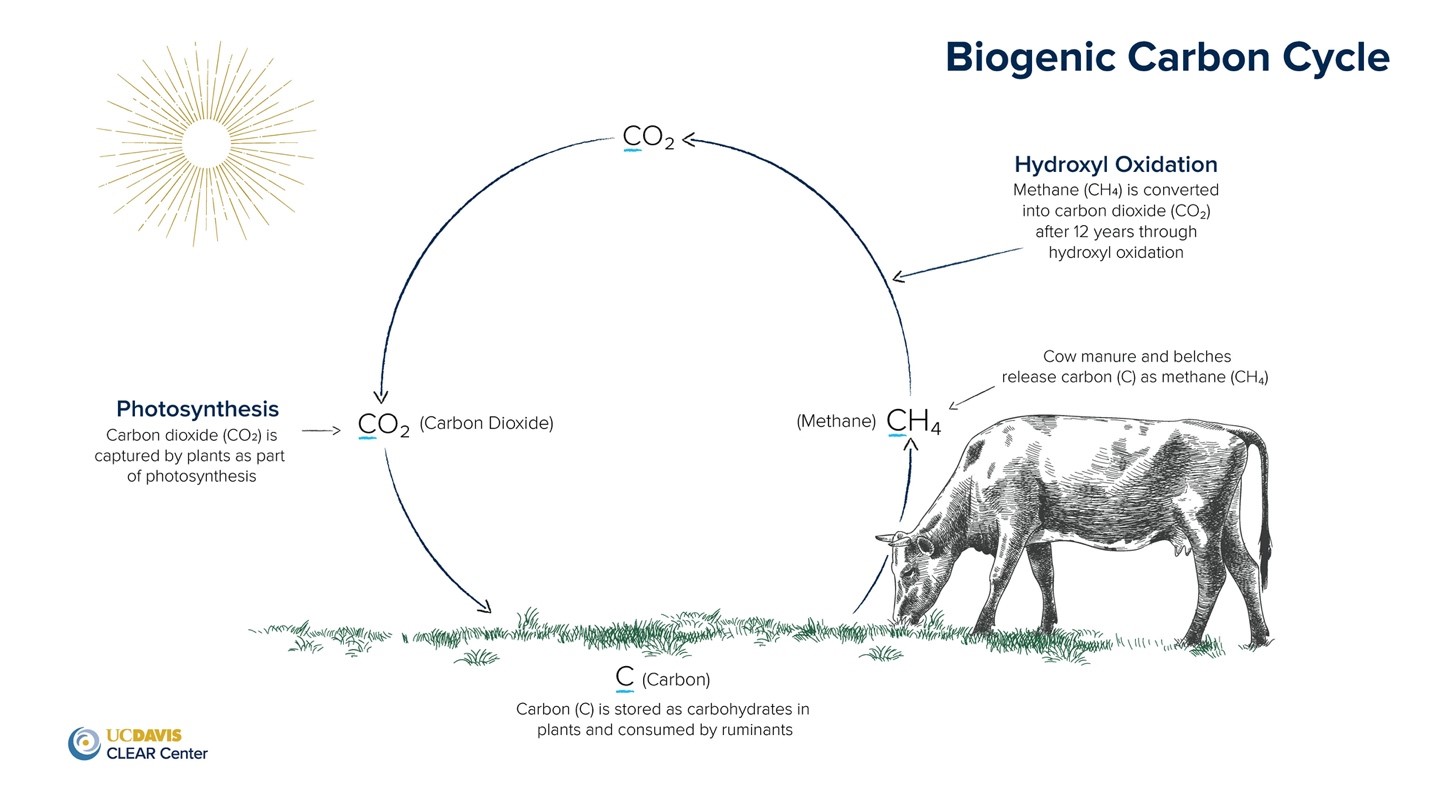
Methane is a potent greenhouse gas with a warming potential more than 28 times that of carbon dioxide (CO2). But when it comes to livestock and climate change, there are many other characteristics that set it apart from CO2. Here are an important four:
- It stays in our atmosphere for about 12 years
- It’s derived from atmospheric carbon, such as CO2
- It’s part of the biogenic carbon cycle
- It eventually returns to the atmosphere as CO2, making it recycled carbon
It should be noted that methane from fossil fuels doesn’t have all the same characteristics as biogenic methane – that is methane from ruminant animals such as cattle, or wetlands. Aside from its short life span, fossil methane shares more traits with CO2 from fossil fuels in how it warms our planet, since it’s not derived from atmospheric carbon (it’s pulled from the earth) and is new to the atmosphere. It’s worth noting that methane emissions from fossil fuel extraction have been severely underestimated.
Methane stays in our atmosphere for 12 years
Methane has a relatively short life of 12 years compared to the hundreds or even thousands of years that CO2 hangs around. After about 12 years, 80 to 89 percent of methane is removed by oxidation with tropical hydroxyl radicals (OH), a process referred to as hydroxyl oxidation. As a result of its short lifespan, methane is only significantly warming our atmosphere for those 12 years, which is why it is considered a short-lived climate pollutant (SLCP).
Its short lifespan is further relevant in regard to warming, because it means that as methane is being emitted it is also being destroyed in the atmosphere, making it a flow gas.
This illustrates that methane’s warming impact isn’t determined by how much is being emitted – since it’s destroyed relatively quickly – but by how much more or less methane is being emitted over a period of time. This is a change in the rate of emission.
What is notable about methane, is that it’s possible the amount being emitted can equal the amount being destroyed. For example, if a herd of cattle emits the same amount of methane over 12 years, they are contributing to warming for those 12 years. But afterward the same amount being emitted is the same that is being destroyed through oxidation, and thus warming is neutral (see Figure 1).
Figure 1: Schematic illustration of how global mean temperatures respond to different emissions trends in carbon dioxide (CO2) and methane (CH4)

It should be pointed out that additional methane outside of that equilibrium – such as before reaching it or adding more after – warms at 28 times that of CO2, making it important we do not increase methane emissions.
But a really intriguing aspect of biogenic methane, is that if we are able to reduce it, such as with dairy digesters, then we can create a cooling effect since there is more methane being destroyed than emitted. These warming and cooling situations are considered in a new climate change matrix called GWP*, which better quantifies the warming effects of short-lived climate pollutants such as methane.
Methane is created from atmospheric CO2
The critical difference between biogenic methane and a fossil fuel greenhouse gas, is that methane from sources like cattle begin as CO2 that is already in the atmosphere. Gases that result from fossil fuel production begin deep in the earth, where they’ve been stored for millions of years, away from the atmosphere.
So how does CO2 become methane? Meet the biogenic carbon cycle
The cyclical nature of biogenic carbon starts with plants. Think back to your grade school years – what do plants need to grow?
Water, sunlight and CO2
As part of the biogenic carbon cycle, plants absorb carbon dioxide, and through the process of photosynthesis, they harness the energy of the sun to produce carbohydrates such as cellulose. Indigestible by humans, cellulose is a key feed ingredient for cattle and other ruminant animals. They are able to break it down in their rumens, taking the carbon that makes up the cellulose they consume and emitting a portion as methane, which is CH4 (note the carbon molecule). After about 12 years, the methane is converted into carbon dioxide through hydroxyl oxidation. That carbon is the same carbon that was in the air prior to being consumed by an animal. It is recycled carbon (see Figure 2 below).
Figure 2: Biogenic Carbon Cycle.

A quick note: while both biogenic and methane from fossil fuels are chemically identical, the resulting CO2 from oxidation has a different warming impact. The biogenic carbon from cattle and wetlands is returned to the atmosphere as that is where it started, while fossil carbon is brand new atmospheric carbon, and hence, new warming.
What does this difference mean?
The difference between biogenic methane and CO2 is significant when we talk about warming, which is ultimately what we care about when discussing greenhouse gases. The current standard for determining how greenhouse gases warm the planet, which is GWP100, doesn’t reflect the differing characteristics of methane and other short-lived climate pollutants from CO2 and long-lived climate pollutants.
If we really want to find climate solutions, then we need to accurately understand how various greenhouse gases actually warm the planet, because we may be missing opportunities to reduce global warming because we misunderstand the roles different greenhouse gases play in climate change. This isn’t to negate the value of GWP100, because it does a good job of representing CO2 and other long-lived climate pollutants, but it’s more productive to look at short-lived climate pollutants in a better way – in other words, having the right tool for the right job.
If our efforts to reduce biogenic methane shouldn’t come at the expense of reducing CO2 from fossil fuels. If they do, then we’re likely to end up with a warmer climate, because the effects of a reduction of biogenic methane would be short lived as the emissions would balance out like mentioned above. On the other hand, CO2 would continue to build up in the atmosphere and warm.
Overall, it is worthwhile to reduce biogenic methane emissions from animal agriculture, as it can buy time for the global community to develop solutions that stop climate change. But we must consider how methane and other greenhouse gases actually warm the planet if we want to have long-lasting effects, otherwise we may nonetheless end up with a warmer planet.
Useful links
Below are useful links giving further explanations:
Methane from fossil fuels – BG – Ideas and perspectives: is shale gas a major driver of recent increase in global atmospheric methane? (copernicus.org) https://bg.copernicus.org/articles/16/3033/2019/
Severely underestimated – Oil and Gas May Be a Far Bigger Climate Threat Than We Knew – The New York Times (nytimes.com) https://www.nytimes.com/2020/02/19/climate/ methane-flaring-oil-emissions.html
12 years – Overview of Greenhouse Gases | Greenhouse Gas (GHG) Emissions | US EPA https://www.epa.gov/ghgemissions/overview-greenhouse-gases#methane
Tropical hydroxyl radicals – Sinks for atmospheric methane – ScienceDirect https://www.sciencedirect.com/science/article/ abs/pii/0306261992900419?via%3Dihub
Flow gas – Greenhouse gas emissions: What is the difference between stock and flow gases? | CLEAR Center (ucdavis.edu) https://clear.ucdavis.edu/news/greenhouse-gas-emissions-what-difference-between-stock-and-flow-gases
Climate metrics under ambitious mitigation https://www.oxfordmartin.ox.ac.uk/publications/ climate-metrics-under-ambitious-mitigation/
Dairy digesters – What is a Dairy Digester and How Does it Affect Methane Emissions? | CLEAR Center (ucdavis.edu) https://clear.ucdavis.edu/explainers/what-dairy-digester-and-how-does-it-affect-methane-emissions
called GWP* – A solution to the misrepresentations of CO 2-equivalent emissions of short-lived climate pollutants under ambitious mitigation | npj Climate and Atmospheric Science (nature.com) https://www.nature.com/articles/s41612-018- 0026-8
Biogenic carbon cycle – The Biogenic Carbon Cycle and Cattle | CLEAR Center (ucdavis.edu) https://clear.ucdavis.edu/explainers/biogenic-carbon-cycle-and-cattle
Methane from fossil fuels – Special Report: Millions of abandoned oil wells are leaking methane, a climate menace | Reuters https://www.reuters.com/article/us-usa-drilling-abandoned-specialreport/special-report-millions-of-abandoned-oil-wells-are-leaking-methane-a-climate-menace-idUSKBN23N1NL
Differing characteristics of methane – Guest post: A new way to assess ‘global warming potential’ of short-lived pollutants (carbonbrief.org) https://www.carbonbrief.org/guest-post-a-new-way-to-assess-global-warming-potential-of-short-lived-pollutant